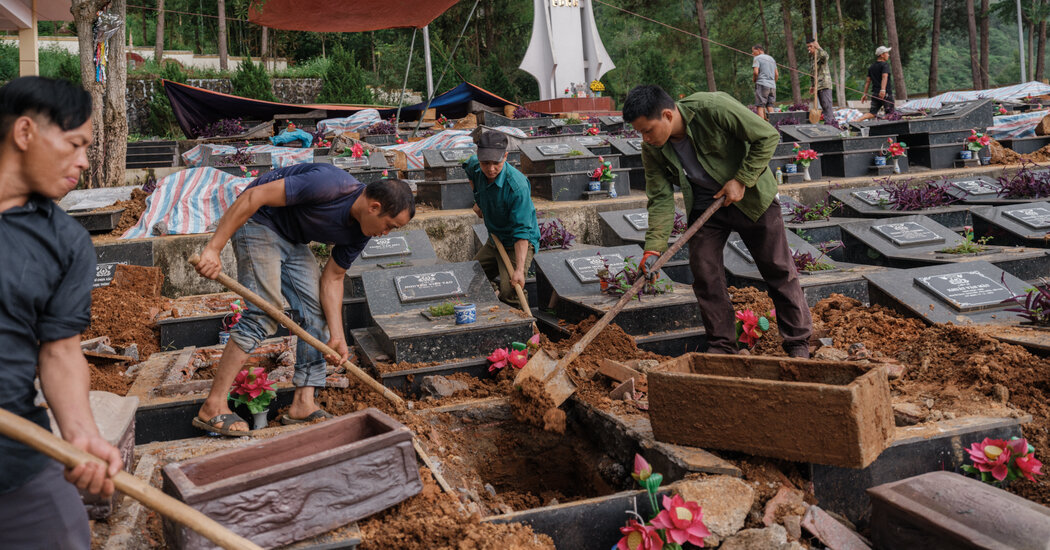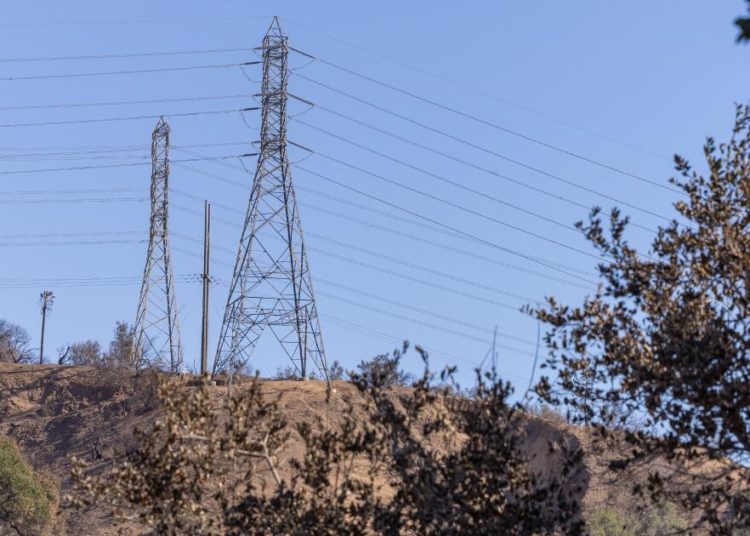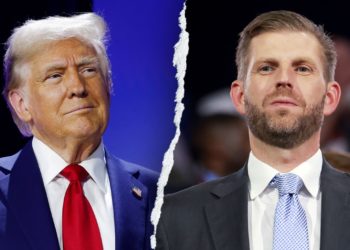The tombstones said “unknown martyr.” The bones were decades old and covered in reddish mud, staining the white lab coats of a half-dozen visiting scientists.
“This tooth good?” asked a junior researcher, holding up a jawbone pulled from a grave.
“No, too decayed,” said his boss, an experienced geneticist. “It has a copper dental crown.”
The search for around 2,600 missing Americans from the Vietnam War has been a first-order issue for Washington and Hanoi ever since the conflict ended. But on that humid June afternoon in northern Vietnam, grave diggers with Ph.D.’s were gathering the bones of Vietnam’s own missing warriors, whose ranks exceed one million, with an urgency and reverence befitting a task long overdue.
The scientists were there to advance a recent breakthrough by putting it to use. A few months earlier, they and their partners — including the International Commission on Missing Persons, in The Hague — had figured out the chemistry and computing required to identify remains as badly degraded as those often found in Vietnam’s acidic, tropical soil. For the first time, tiny snips of DNA taken from bones up to 70 years old could be used to link the country’s fallen soldiers to distant relatives, unlocking lost truths and deeper healing.
Families from Vietnam’s north and south, their anguish still festering 50 years after the war ended, could find reconciliation in graves where their war dead lie together. Americans still unaccounted for might be found, too, as Vietnam’s identification efforts expanded. Methods honed locally could also extend far beyond Vietnam, to help identify those lost to wildfires, typhoons or other natural disasters worldwide.
“Groundbreaking,” said Tim McMahon, director of DNA operations for the U.S. Defense Department. That’s how he described the new methods of accounting for the lost, adding: “It’s the next jump in identification.”
One thing that DNA analysis requires, however, is practice. Repetition at scale improves technique. But for Vietnam and the world, the opportunity that comes with the largest human identification project on the planet is now being threatened by the Trump administration’s hostility toward foreign aid.
The five-year grant from the United States that had sustained Vietnam’s DNA project — paying for sequencing machines and collaborations with the U.S. military and the International Commission on Missing Persons — was suspended with the dismantling of U.S.A.I.D. in January. The restored money that’s left runs out in September.
Before the disruptions, the scientists doing exhumations said they had aimed to identify 1,000 Vietnamese M.I.A.’s by July 11, the 30th anniversary of normalized U.S.-Vietnam relations. That, they believed, would prove what former enemies could accomplish by pursuing closure through science.
Now they are hoping for one.
What Vietnam Wants
Thousands of miles from Washington, in Ho Chi Minh City, Vu Thi Ninh Thuy, 42, shared a common Vietnamese war story.
A parade marking the 50th anniversary of the end of the conflict had just finished. As graying veterans strolled past the hotel where U.S. generals once briefed reporters on daily body counts, she brought up her uncle, who vanished while fighting the Americans in 1974.
Her eyes darting with emotion, she recounted how her childhood had been filled with exploratory trips south and north to look for him. Her family questioned his comrades. They visited local officials and eventually found a psychic who directed them, incorrectly, to a location not far from where we stood on that April morning.
“We all feel restless until we can find their remains,” she said. “Everyone who is Vietnamese wants to bring their loved ones closer to home.”
Modern psychology teaches that “ambiguous loss” — where death remains unverified and without resolution — freezes the grieving process, leading to chronic sorrow. In Vietnam, the pain is compounded by ancient beliefs.
The country’s common practice of ancestor worship, with offerings left at graves and shrines, dictates that if the dead aren’t interred with other ancestors, the person’s soul wanders homeless and hungry. Burying and honoring the dead is considered an obligation of the living.
Vietnam’s official efforts to account for those killed in the war have often been haphazard and hampered by bureaucracy. The remains of at least 300,000 fighters for North Vietnam have been found but not identified.
In 2014, the Vietnamese government took a major step toward addressing those shortcomings, announcing that it would invest $25 million in a DNA identification project. A new lab opened on the outskirts of Hanoi in 2019.
A year later, the International Commission on Missing Persons came on board. The project expanded with $7.4 million from U.S.A.I.D., awarded over five years, a fraction of what is spent annually to find and identify missing Americans.
Experts like Thomas Parsons have tried to fill gaps in the effort. Wiry and lean, with a frame easily lost in a lab coat, Dr. Parsons is a globally recognized authority on forensic genetics and the international commission’s lead scientist in Vietnam.
When we met in March at the lab near Hanoi, he resembled a mountain climber with no mountain to climb. On a table, a NextSeq 1000, a “high-throughput” sequencing system delivered in November at a cost of about $220,000, sat idle. It was one of many sophisticated machines covered in plastic after U.S.A.I.D.’s elimination.
Dr. Parsons and his Vietnamese colleagues stressed that U.S. foreign aid was not a handout, but rather a way to train Vietnam’s researchers for an ambitious task using new genetic methods and technologies.
“We’ve already achieved a lot,” said Tran Trung Thanh, a molecular biologist and the lab’s deputy director. “We need more time to apply it in practice.”
The main breakthrough occurred a few months before Mr. Trump’s inauguration with 23 Vietnamese bone samples degraded by age and tropical conditions. Using chemical solutions and high-tech analysis, scientists from the international commission found that 70 percent of the samples generated DNA profiles capable of being matched to a parent or child.
Several samples generated enough genetic material to connect with a single great-great-grandchild or even a first cousin’s child or parent.
Before last year, nine of every 10 Vietnamese bone samples yielded nothing identifiable.
“The breakthrough is the successful implementation in Vietnam of these tools that are emerging from the cutting edge of forensic science, in a context where other methods fail,” Dr. Parsons said.
Another scientist compared their work to searching for crumbs of a corn flake in a mountain of sand.
Duty and Doubts
Bob Connor, 78, a chatty Air Force veteran who lives near Philadelphia, signed up to fight Communists as a young man. More recently, he helped find a mass grave for their dead that he had heard about during a tour outside Saigon in 1968.
Since 2016, Mr. Connor says, he has located around 8,000 unidentified Vietnamese. The official tally of Americans who went missing during the Vietnam War is 2,646.
“The families are the key to the whole thing, from a standpoint that it’s no different from our M.I.A.’s,” he said.
“Should we walk away from it — hell no,” he added. “We owe it to them.”
Since Mr. Clinton announced the restoration of diplomatic relations 30 years ago, Vietnam has handed over more than 1,000 sets of American remains.
Ambassador Marc Knapper, the son of a Vietnam veteran, has lobbied behind the scenes for the United States to continue supporting Vietnam’s M.I.A. program. The International Commission on Missing Persons also wrote to Secretary of State Marco Rubio asking that funding be restored.
In March, the project received a partial reprieve. U.S. officials told scientists that they would receive the money allotted through the fiscal year, which ends Sept. 30.
A State Department spokesman said that maintaining “the right mix of programs to support U.S. national security and other core national interests of the United States requires an agile approach.”
Even without such uncertainty, the U.S.-Vietnam relationship has already been battered. Vietnam and the United States on Wednesday reached a preliminary agreement that will add tariffs of 20 to 40 percent on imports from Vietnam — a major blow for its economy that follows sharp cuts in foreign aid for health, education and the environment..
Mr. Trump’s approach “has shaken Vietnamese confidence in the United States,” said Tim Rieser, a former adviser to Senator Patrick J. Leahy of Vermont, a key figure in U.S.-Vietnam reconciliation. “They have told us the Chinese are already stepping into the vacuum.”
Reduced ambitions for partnership with the United States are increasingly the norm.Instead of requesting another five-year grant, the International Commission on Missing Persons has requested $3 million from the United States to keep the project going for 12 to 18 months.
“If we don’t receive funding beyond September,” Kathryne Bomberger, the commission’s director general, said in an interview, “the program will probably end.”
If that happens, American remains commingled with those of Vietnamese soldiers may never be found, and growth in humanitarian identification will be stunted. Families on the cusp of clarity will remain in limbo for longer, and possibly forever.
At the cemetery in the country’s north, the scientists soldiered on, maintaining faith in their grisly labor.
They had just a few weeks to make an identification, maybe for remains from the “American War,” maybe from a war against China in 1979.
On their final day, a family appeared, laying out fruit and dove-white flowers and lighting incense at the grave of a soldier lucky enough to have been buried with a name.
Dr. Thanh, the project’s deputy director, watched quietly as the scratch of shovels on dirt mingled with birdsong.
“We just want to bring certainty,” Dr. Thanh said. “To give people information they’ve never had.”
Tung Ngo contributed reporting.
Damien Cave leads The Times’s new bureau in Ho Chi Minh City, Vietnam, covering shifts in power across Asia and the wider world.
The post Vietnam Aches for Its M.I.A.’s. Will America Stop Funding Science to Identify Them? appeared first on New York Times.




